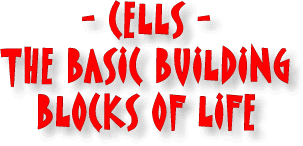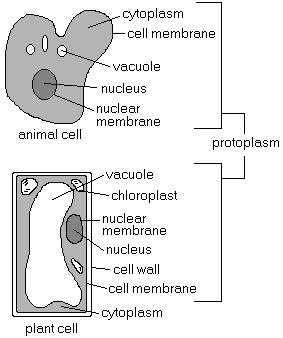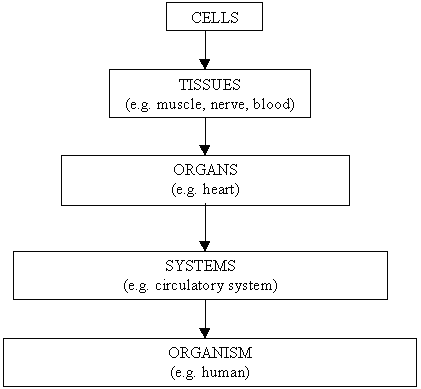
CELL COMPONENTS

- Nucleus - The nucleus is the control centre or 'brain' of the cell, and controls all chemical reactions and activity of the cell.
- Cytoplasm - The cytoplasm is the jelly-like substance outside the nucleus that contains the cell's nutrients and oxygen.
- Cell Membrane - The cell membrane is the 'skin' that holds the cell together.
- Cell Wall - The cell wall is an extra wall in plant cells only.
- Chloroplasts - These small containers of the green pigment, chlorophyll, are only in plant cells. Chlorophyll is used in the process of photosynthesis.
DIFFERENCES BETWEEN ANIMAL AND PLANT CELLS
- Both animal and plant cells contain a nucleus, cytoplasm and a cell membrane.
- Only plant cells contain a cell wall and chloroplasts.
RULES FOR USING MICROSCOPES
Setting up and putting away the microscope
- When using lamps, always take care because the bulb is easily 'blown' when the bulb is hot. After use, allow about five minutes for the bulb to cool before moving it.
- Do not look through the microscope while lowering the body tube.
- Clean lenses with lens tissue. Wipe the body and the stage before putting the microscope away.
- Always turn the objective lens to the low power (shortest) before putting it away.
Procedure
- When you begin, use the focusing knob to raise the objective lenses well above the stage.
- Swing the lowest power objective lens (shortest) into place.
- Clip the slide with the specimen onto the stage.
- Move the specimen directly under the objective lens.
- Use the focus knob to focus with the low power lens. The lens should always be at least 2mm from the slide. It should never touch the slide.
- Then focus with the medium power objective lens (medium sized one).
- Lastly, focus with the high power objective lens (longest).
- Decide which magnification - low, medium or high - gives the best view.
DRAWING CELLS
- Diagrams should be drawn with fine pencil lines without shading.
- Diagrams should be about 1/3 of a page.
- All parts should be labelled with horizontal arrows.
- The title should include the magnification.
- Total Magnification = Eyepiece Lens Magnification X Objective Lens Magnification
RESPIRATION AND PHOTOSYNTHESIS
- Respiration is the process by which all cells obtain their energy. It is the 'burning' of glucose sugar and oxygen to produce energy, carbon dioxide and water.
Glucose Sugar + Oxygen
Energy + Carbon Dioxide + Water
C6H12O6 + O2 ![]() Energy + CO2 + H2O
Energy + CO2 + H2O
- Photosynthesis is the process used by plant cells only to make glucose sugar and oxygen using green chlorophyll, sunlight, carbon dioxide and water
Carbon dioxide + Water ![]() Glucose sugar + Oxygen
Glucose sugar + Oxygen
CO2 + H2O ![]() C6H12O6 + O2
C6H12O6 + O2
THE ORGANISATION OF ORGANISMS
